Carlow Rifles were part of the 8th Battalion King's Royal Rifle Corps
-

- 1880 CR cap badge
|
|
-

- The Kings Royal Rifle Corps' drum
taken from Carlow Barracks.
Source: Jake Duggan
|
-

- Reverse
|
1881. The King's Royal Rifle Corps reorganised without county affiliation upon territorialisation
of the infantry, but taking responsibility for some Militia in
Huntingdonshire, Middlesex, Flint, Carlow and Cork, and some Volunteers in
Middlesex.
-
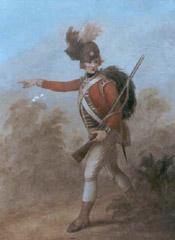
- The Original Light Infantryman c.1759
|
-
|
-
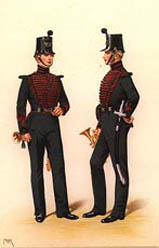
- Buglers King's Royal Rifle Corps 1851
|
-
|
-
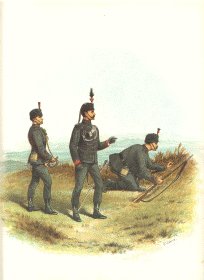
- The King's Royal Rifle Corps c1881
|
-
|
-
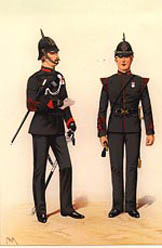
- Officer and Bugler King's Royal Rifle
Corps 1890
|
KINGS ROYAL RIFLE CORPS
- This regiment was originally raised in New York and Philadelphia (1755)
as the 62nd Royal American Regiment of Foot, it was renumbered 60th in 1757
(the regiment was in the West Indies during the American war of
Independence). A special act of parliament was passed allowing it to
commission foreign officers, it was referred to by some as the British
Foreign Legion. From the beginning it consisted of four battalions although
over the years this number varied as needs dictated peaking at eight during
the Napoleonic period and reducing to two in 1815. In 1824 the remaining
foreigners were drafted out of the regiment, one battalion was converted to
rifles, the other light infantry (the uniform was changed from red to green
as was the norm with rifle regiments). They were renamed the 60th Duke of
York's Rifle corps and Light Infantry which was soon changed to the 60th
Duke of York's Own Rifle Corps and changed again in 1830 to the 60th Kings
Royal Rifle Corps.
-
- 1st Bn: Raised as the 2nd in 1755 and served all its time in either
America or the West Indies until 1824 when it was brought to England (the
remaining foreign soldiers were left behind in Canada) The number was
changed to 1st in 1818 when the old 1st was disbanded.
- 2nd Bn: Raised in 1787 as the 3rd, renumbered 2nd in 1818. It was brought
to England in 1830 and also left soldiers on the other side of the Atlantic.
- 3rd Bn: Raised in Dublin 1855.
- 4th Bn: Raised in Winchester 1857.
- 5th Bn: Formerly the Huntingdon Militia Rifles.
- 6th Bn: Formerly the Royal Flint Militia Rifles. Disbanded 1889.
- 7th Bn: Formerly the 2nd Middlesex Royal Edmonton Militia Rifles.
- 8th Bn: Formerly the Carlow Rifles Militia.
- 9th Bn: Formerly the North Cork Militia Rifles.
-
- There were also 11 volunteer battalions all based in either London or the
home counties.
In 1966 this regiment was merged with the Rifle Brigade and the
Oxfordshire Light Infantry to become The Royal Green Jackets.
Source: IRISH CAVALRY REGIMENTS
Margaret Emma; married. John Charles
Lloyd, Capt. Carlow Rifles, son. of Major Owen Lloyd, of Rockville, Co.
Roscommon, and had issue of one son,
Source THE WALDRONS OF ILLAWARRA
Colonel Joshua Kearney “Jerry” Millner
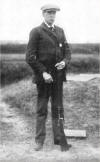 Colonel Joshua Kearney “Jerry” Millner was born in
Smithfield, Dublin on July 5th 1847 to a wealthy family of wool merchants.
At the age of 24 in 1871 he joined the Dublin Shooting Club and two years
later was chosen for the Irish rifle team to shoot for the Elcho Challenge
Shield.
Colonel Joshua Kearney “Jerry” Millner was born in
Smithfield, Dublin on July 5th 1847 to a wealthy family of wool merchants.
At the age of 24 in 1871 he joined the Dublin Shooting Club and two years
later was chosen for the Irish rifle team to shoot for the Elcho Challenge
Shield.
His skill with a rifle earned him the rank of Lieutenant
Colonel in the Carlow Rifles Militia, although he never saw active service.
Source and more information
Charles Kearns Deane Tanner
Charles Kearns Deane Tanner of the Kings Royal Rifle Corps
known familiarly as the Carlow Rifles was the father of
William Cunningham Deane-Tanner who was born in Carlow, April 26, 1872.
Major KD Tanner was elected as Captain of the Carlow
Volunteer Fire Brigade.
Carlow Volunteer Fire Brigade Captain 'Major
Kearns Deane-Tanner 1842 – 1902
• Major Kearns Deane‐Tanner, Born in Cork, was an
officer in the Carlow Rifles, who had lately served with the British
force that helped crush the Taiping Rebellion in China and was Father of
William Desmond Taylor • William Desmond Taylor was 49 years old when
the bullet that killed him ploughed into his back on 2nd February 1922.
The murder of the popular Irish film director was to become one of the
greatest unsolved crimes in Hollywood history.
• Taylor’s real name was William Cunningham
Deane-Tanner. Born just outside Carlow Town on 26th April 1872, he the
second of four children for Major Kearns Deane-Tanner
• In June 1902, Former Volunteer Fire Brigade Captain
Kearns Deane-Tanner died of blood poisoning in Dublin.
Source: http://www.carlowlibraries.ie/documents/fireservice.pdf